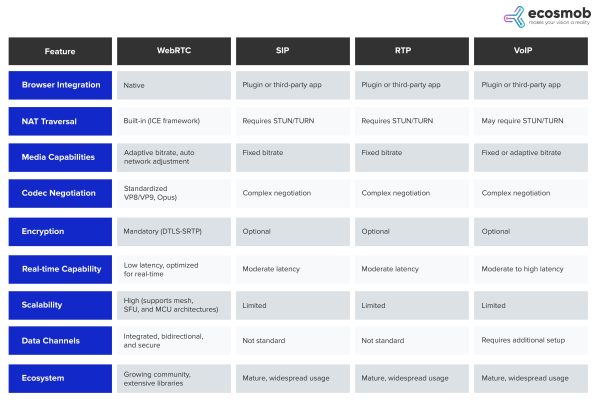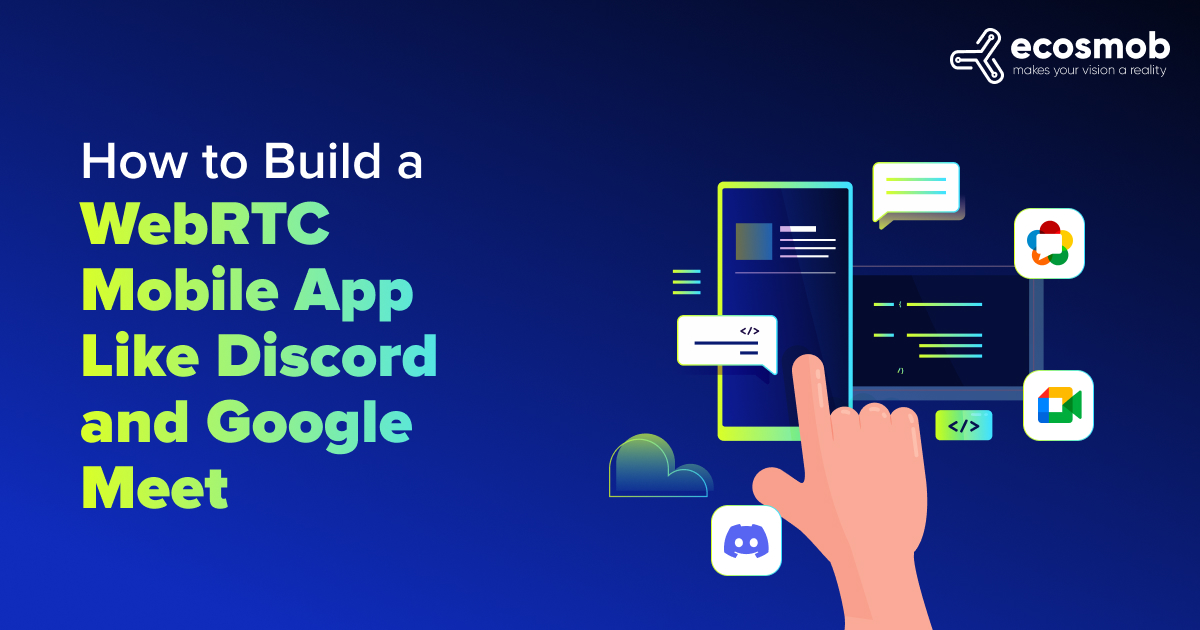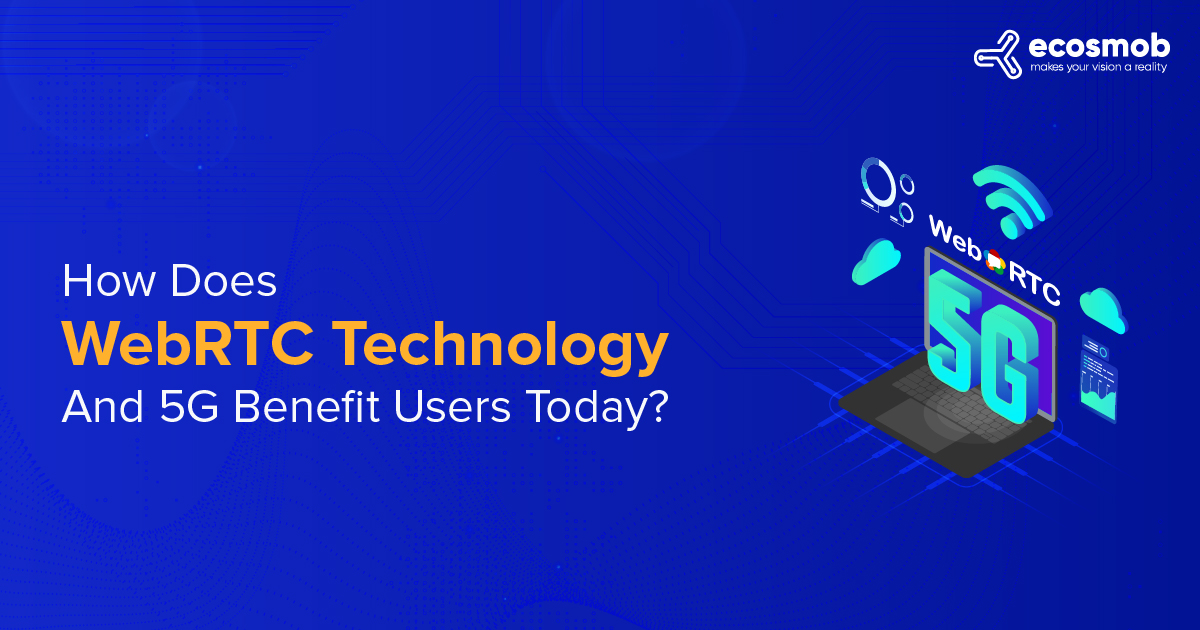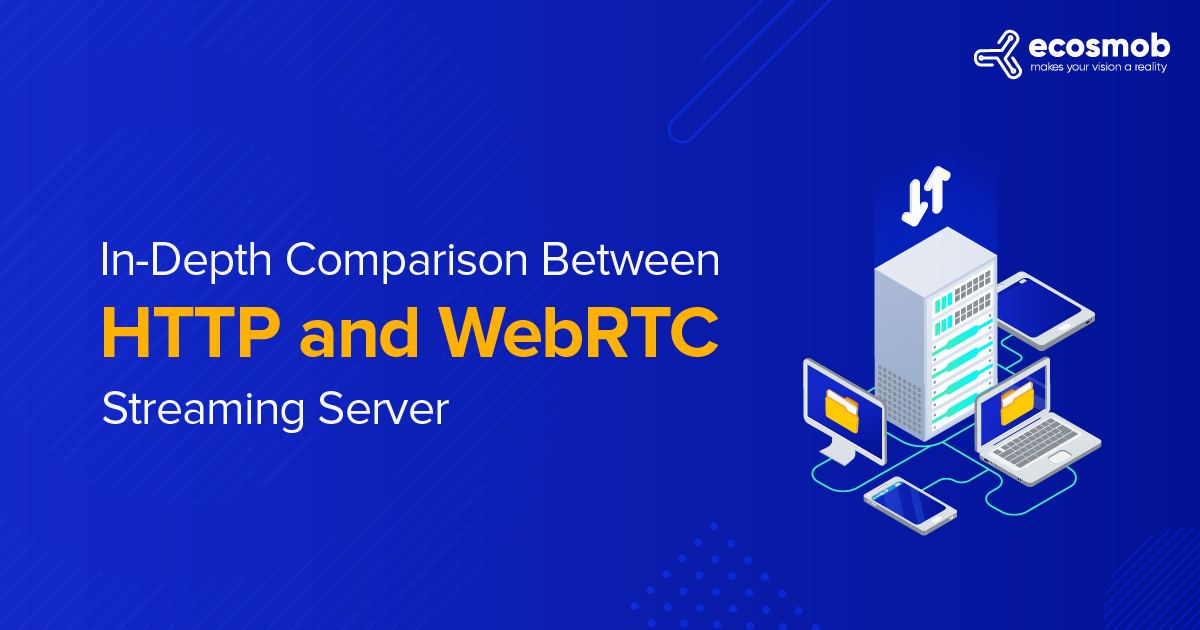We have all witnessed a significant shift ever since the advent of WebRTC. This powerful open-source project has redefined real-time communication over the web. As traditional communication protocols like SIP, RTP, and VoIP grapple with the innovations brought forth by WebRTC, it’s crucial to dissect the comparative advantages and limitations of these technologies.
Through this comparative analysis, let’s explore the intricacies of WebRTC vs. traditional communication protocols. You’ll leave knowing why WebRTC is becoming the preferred choice for modern communication needs!
Step into the future with custom WebRTC solutions.
What is WebRTC?
WebRTC, or Web Real-Time Communication, is a cutting-edge technology that enables browser-to-browser applications for voice calling, video chat, and P2P file sharing without needing plugins or third-party software. It is a great leap forward and offers a seamless communication experience directly from the web browser.
WebRTC vs. Traditional Communication Protocols: The Fundamental Differences
Traditional communication protocols such as Session Initiation Protocol (SIP), Real-Time Protocol (RTP), and Voice over Internet Protocol (VoIP) have been the backbone of digital communication systems for decades. These protocols are designed to initiate, maintain, and terminate real-time sessions across networks.
However, they often require additional software, hardware, or both, leading to higher costs and complexity in deployment.
On the flip side, WebRTC simplifies real-time communication by embedding these capabilities natively in the web browser, eliminating the need for specialized equipment or software installations. This intrinsic simplicity and cost-effectiveness make WebRTC a game-changer.
Here’s how WebRTC compares to traditional communication protocols on various fronts:
- Protocol Overheads and Performance: Traditional protocols such as SIP and RTP are laden with protocol overheads that can affect performance. In contrast, WebRTC is designed to minimize overhead, with a more efficient and streamlined communication experience.
- NAT Traversal: Traditional protocols struggle with NAT traversal, often requiring additional infrastructure such as STUN or TURN servers. WebRTC inherently handles NAT traversal through the Interactive Connectivity Establishment (ICE) framework, making connections more reliable.
- Codec Support: SIP and RTP require codec negotiation, which can be complex. WebRTC simplifies this by supporting standard codecs like VP8/VP9 for video and Opus for audio, promoting interoperability.
- Encryption: Encryption is optional in many traditional protocols, but WebRTC mandates end-to-end encryption using Secure Real-time Transport Protocol (SRTP), enhancing security for all parties involved.
Here is an exciting read: Technical Aspects of WebRTC: What, Why, and How? That covers all the technical facets of WebRTC.
WebRTC vs. Traditional Protocols: Individual Comparisons
Let’s compare WebRTC directly with established protocols like SIP, RTP, and VoIP to highlight how it’s changing the game in digital communication.
WebRTC vs. SIP
SIP, short for Session Initiation Protocol, serves as a signaling protocol to initiate, maintain, and end real-time communication sessions. These sessions can involve video, voice, messaging, and other communications applications. While SIP has been instrumental in the growth of VoIP, as per Persistence Market Research, it falls short when it comes to traversing network firewalls. It requires additional components like SIP proxies and session border controllers to function effectively.
WebRTC addresses these challenges head-on by using a set of real-time protocols that work across modern firewalls and can run directly in the browser. This eliminates the need for network configurations and allows for a more direct and secure communication pathway.
WebRTC vs. RTP
RTP, known as Real-time Transport Protocol, facilitates the transmission of audio and video data across IP networks. However, RTP does not handle network address translation or facilitate traversal of firewalls, which are critical in today’s network environments.
WebRTC incorporates advanced media streaming capabilities, including adaptive bitrate streaming and automatic adjustment to network conditions. This not only enhances the quality of communication but also ensures consistency in performance across diverse network conditions.
WebRTC vs. VoIP
VoIP technology helps with the transmission of voice communication over the Internet. However, integrating VoIP into web applications can get cumbersome as it often requires additional plugins or software.
WebRTC transcends this limitation by providing native support for voice communication within web applications. This streamlines the integration process and enhances user experience.
An in-depth Guide to WebRTC Development gives you a further holistic viewpoint on webRTC development and work.
Choosing WebRTC
Choosing the right technology is a strategic decision that will pave the way for secure and efficient digital communication for your business. Let’s look at some core reasons why WebRTC stands out.
Security Considerations
Security is paramount in digital communication, and WebRTC has been designed with robust security features at its core. It employs end-to-end encryption for all communication, ensuring that voice, video, and data remain secure from eavesdropping or tampering.
In contrast, traditional protocols often require additional security measures, complicating their implementation and effectiveness.
The Business Implications of Choosing WebRTC
Adopting WebRTC offers businesses a competitive edge with the ability to provide real-time communication features directly on their websites or applications. This can significantly enhance customer engagement and satisfaction while reducing costs associated with traditional communication systems.
Use Cases Where WebRTC Shines
WebRTC’s versatility shines across various use cases, each showcasing its strengths over traditional protocols.
- Video Conferencing: WebRTC’s ability to handle high-quality video and audio natively in browsers without additional plugins makes it ideal for video conferencing platforms.
Here is How WebRTC Video Conferencing Works In Different Industries. - Peer-to-Peer File Sharing: By allowing direct data transfer between browsers, WebRTC facilitates quick and secure file sharing without relying on intermediate servers.
- Live Streaming: Content creators can leverage WebRTC’s efficient media streaming capabilities for broadcasting live events with minimal latency.
- Telehealth: In the healthcare sector, WebRTC enables secure and reliable teleconsultations, allowing for seamless patient-doctor interactions.
A Quick Look
Let’s have a quick comparative look at WebRTC vs. SIP, RTP, and VoIP.

The Future Is WebRTC
As we move towards a more interconnected and browser-centric world, the limitations of traditional communication protocols become increasingly apparent. WebRTC, with its open standards, ease of use, and superior security features, is rapidly becoming the new standard for real-time communication on the web.
In conclusion, while traditional protocols have served us well in the past, the future belongs to WebRTC. Its unparalleled efficiency, cost-effectiveness, and seamless integration into modern web environments make it the superior choice for businesses and individuals.
As WebRTC continues to evolve, it is set to revolutionize digital communication. And this is not a bandwagon you want to miss jumping on. Partnering with an experienced team that consistently works on staying with the latest technology can be the ladder to your business’ success. For all your communications needs, team Ecosmob is here to empower you with the best of WebRTC!
Transform your digital interactions with bespoke WebRTC solutions.
FAQs
-
Can WebRTC be used in non-browser environments?
Yes, WebRTC can be implemented in non-browser environments such as mobile applications and Internet of Things (IoT) devices, offering a wide range of communication capabilities outside traditional web browsers.
-
Does WebRTC support multi-party conferencing?
Yes, WebRTC supports multi-party conferencing through different architectures such as mesh, Selective Forwarding Units (SFU), and Multipoint Control Units (MCU).
-
Is there a licensing fee for using WebRTC?
No, WebRTC is an open-source project, which means it is free to use and implement without any licensing fees.
-
Can WebRTC integrate with existing VoIP infrastructure?
WebRTC can be integrated with existing VoIP infrastructure using gateways, translating between WebRTC protocols and traditional VoIP signaling.
-
Are there any limitations to WebRTC’s scalability?
While WebRTC is highly scalable, the degree of scalability can depend on the signaling mechanism and architecture used. For large-scale applications, you may require additional infrastructure like SFUs.

















